Introduction
Welcome to Kruger National Park, a vast and iconic wilderness in South Africa, renowned for its stunning landscapes and diverse wildlife. Spanning over 2 million hectares, it offers a world-class safari experience, showcasing the beauty and richness of Africa’s natural heritage.
While the park is celebrated for its diverse wildlife, most notably the Big Five, it also boasts an impressive array of bird species. Among these 500-plus winged wonders are the majestic Lappet-faced Vultures, the powerful Martial Eagles, the striking Saddle-billed Storks, the grand Kori Bustards, the elusive Pel’s Fishing Owls, and the charismatic Ground Hornbills. These remarkable birds form what is known as Africa’s Big 6, adding a spectacular avian dimension to the park’s allure.
In this blog, we will take flight into the world of these Big Six Birds of Kruger, exploring their unique traits and the vital roles they play in the park’s ecosystem.
Lappet-Faced Vultures
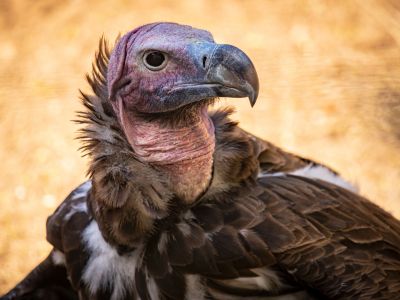
The Lappet-Faced Vulture, with its strikingly large size and distinctive wrinkled facial skin, is one of Kruger National Park’s most impressive avian residents. These vultures, easily identifiable by their red heads and powerful beaks, are vital to the park’s ecosystem. As scavengers, they play a crucial role in maintaining the health of the environment by feeding on carrion, thus preventing the spread of disease.
One of the key roles of Lappet-Faced Vultures in the ecosystem is their ability to clean up after predators. When large animals like lions or hyenas leave behind carcasses, these vultures swoop in to finish off the remains. Their strong beaks allow them to tear through tough hides and sinew, making them indispensable in the breakdown and recycling of organic matter. This not only helps keep the landscape free from rotting flesh but also ensures that nutrients are returned to the soil.
Moreover, the presence of Lappet-Faced Vultures is a strong indicator of a healthy and balanced ecosystem. They often dominate over other scavenger species due to their size and strength, ensuring that no part of a carcass goes to waste. By doing so, they help sustain a diverse array of wildlife within the park. Watching these majestic birds in action is not just a glimpse into the circle of life but also a testament to the intricate and essential roles that each species plays in maintaining ecological harmony.
Martial Eagles
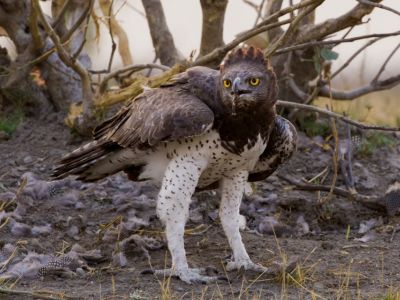
Martial Eagles, the largest eagles in Kruger National Park, are remarkable predators with a wingspan that can reach up to 2.6 meters. Their keen eyesight allows them to spot potential prey from great heights, and their formidable talons and strong beaks make them effective hunters. By preying on a variety of animals, including small mammals, reptiles, and other birds, Martial Eagles help control the populations of these species, preventing any one group from becoming too dominant.
One of the key ecological roles of Martial Eagles is their contribution to the health and diversity of prey populations. By selectively hunting the sick, weak, or young individuals, they help maintain the genetic health of these populations. This natural selection process ensures that only the fittest individuals survive and reproduce, contributing to the overall resilience and adaptability of the species they hunt. Additionally, the presence of these apex predators indicates a well-functioning and thriving ecosystem, as they require large territories and abundant prey to sustain themselves.
Moreover, Martial Eagles play a significant part in the food chain, benefiting other scavengers in the park. After a successful hunt, they often leave behind leftovers that provide a vital food source for smaller scavengers such as jackals, hyenas, and various bird species. This interconnectedness highlights the importance of Martial Eagles in the broader ecological community. Observing these magnificent raptors in action is not only a thrilling experience but also a reminder of the intricate and essential roles each species plays in preserving the natural balance of Kruger National Park.
Saddle-Billed Storks
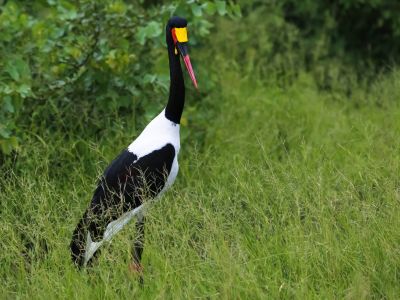
Saddle-Billed Storks, with their striking black and white plumage and vibrant red and yellow bills, are a captivating sight in Kruger National Park. These tall, elegant birds are expert fishers, using their long, sharp bills to catch fish, frogs, and other aquatic prey. By controlling fish populations in rivers and wetlands, they help maintain a balanced aquatic ecosystem, ensuring that no single species overwhelms the habitat.
Beyond their role as predators, Saddle-Billed Storks contribute to the health of Kruger’s wetlands by aerating the soil and water as they wade and hunt. This activity helps to keep these environments dynamic and fertile, supporting a diverse range of plant and animal life. Their presence in the wetlands indicates a healthy, functioning ecosystem, as they require clean, undisturbed waters to thrive.
Saddle-Billed Storks also play a crucial part in the food web by providing food for other animals. After a meal, the leftovers and any fish that escape their grasp become available to other scavengers, ensuring that no resource goes to waste. Additionally, their nesting sites, often in large trees, can be used by other bird species once the storks have moved on, offering valuable habitats for a variety of wildlife. The majestic Saddle-Billed Stork is not just a beautiful bird to observe but a vital component in maintaining the ecological balance of Kruger’s rich and diverse environment.
Kori Bustards
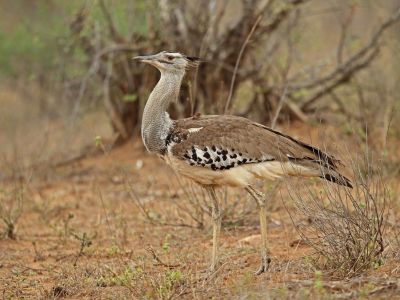
Kori Bustards, among the heaviest flying birds in the world, are a fascinating presence in Kruger National Park. These majestic birds, with their striking plumage and impressive size, play a crucial role in the savannah ecosystem. As omnivores, Kori Bustards consume a diverse diet that includes insects, small vertebrates, seeds, and berries. By doing so, they help control insect populations and disperse seeds, contributing to the health and diversity of the vegetation.
Their foraging behaviour has a significant impact on the ecosystem as well. As Kori Bustards move through the grasslands in search of food, they disturb the soil, aiding in the aeration process. This activity promotes healthy plant growth and helps maintain the grassland’s structure.
Kori Bustards also play a role in the food chain, both as predators and as prey. Their eggs and chicks are preyed upon by various predators, contributing to the survival of other species within the ecosystem. As adults, their vigilance and ability to spot danger from afar serve as an early warning system for other animals, enhancing the overall safety of the community. The presence of Kori Bustards in Kruger not only enriches the park’s biodiversity but also underscores the interconnectedness of its inhabitants.
Pel’s Fishing Owls
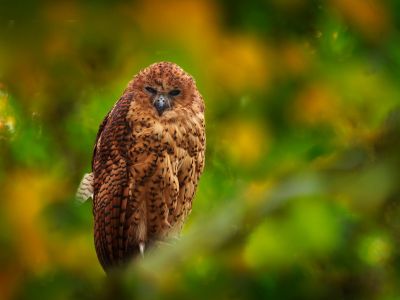
Pel’s Fishing Owls are elusive yet enchanting residents of the Kruger National Park. With their strikingly large eyes and formidable talons, these owls are masterful hunters, specialising in catching fish and other aquatic prey. Their keen eyesight and powerful beaks allow them to detect and capture prey even in low-light conditions. Beyond regulating fish populations, Pel’s Fishing Owls contribute to a balanced aquatic ecosystem by controlling other water-dwelling species and maintaining biodiversity. These owls are also known for their distinctive, haunting calls that echo through the night, adding an air of mystery to the park’s nighttime symphony.
Their hunting techniques are a marvel to observe. Pel’s Fishing Owls use their exceptional night vision and keen hearing to detect prey in the water, swooping down with precision to catch fish. This predatory behaviour indirectly benefits other species as well; by preying on fish, they leave behind nutrients and organic matter that contribute to the health of the waterways. This, in turn, supports a variety of other aquatic and terrestrial species that rely on these water sources.
Beyond their role as predators, Pel’s Fishing Owls also serve as important indicators of environmental health. Their presence signals a healthy, thriving ecosystem, as they require clean, unpolluted waters and abundant prey to survive. Conservation efforts to protect these owls and their habitats have a broader impact, benefiting many other species that share their environment. The enigmatic Pel’s Fishing Owl is thus not only a symbol of the rich biodiversity within Kruger National Park but also a crucial component of its ecological balance.
Ground Hornbills
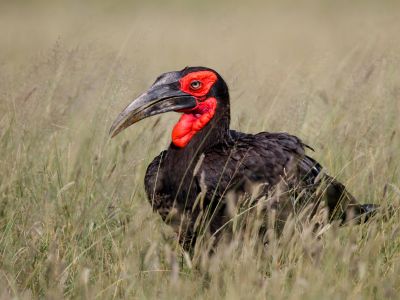
Ground Hornbills, with their striking appearance and unique behaviours, are large, terrestrial birds are easily recognisable by their black plumage and vivid red facial skin. They are known for their cooperative breeding habits, where a dominant pair is assisted by other group members in raising their young. This social structure strengthens the bond within the group and ensures the survival of the offspring, contributing to the species’ overall population stability.
Ground Hornbills are not only apex predators in their ecosystem but also play several critical ecological roles. Their diet, which includes small mammals, reptiles, and insects, helps regulate these populations, ensuring a balanced ecosystem. Interestingly, Ground Hornbills are also vital seed dispersers. As they consume fruits and seeds, they inadvertently help in the propagation of various plant species, contributing to forest regeneration and biodiversity.
Additionally, their large, sturdy beaks are adept at foraging through the leaf litter and soil, aiding in the breakdown of organic material and promoting soil health. Their presence in the ecosystem supports a diverse range of species and contributes to the overall vitality of their habitat.
Conclusion
The bird life of Kruger National Park is nothing short of spectacular. The Big 6 Birds—Lappet-faced Vultures, Martial Eagles, Saddle-billed Storks, Kori Bustards, Pel’s Fishing Owls, and Ground Hornbills—showcase the incredible avian diversity and beauty of the African bush. These majestic birds not only captivate birdwatchers and nature enthusiasts but also play vital roles in maintaining the ecological balance of the park.
Each of these birds has a unique story and a crucial part to play in the ecosystem. From the scavenging efficiency of the Lappet-faced Vultures to the predatory prowess of the Martial Eagles, these birds help control populations of other species, ensuring a balanced and healthy environment. The elegant Saddle-billed Storks and the impressive Kori Bustards contribute to the diversity of habitats, while Pel’s Fishing Owls and Ground Hornbills reflect the health and richness of Kruger’s waterways and savannahs.
Exploring Kruger’s birdlife offers a deeper appreciation of the intricate web of life that thrives within the park. Whether you a re a seasoned birder or a casual observer, witnessing these magnificent birds in their natural habitat is a truly enriching experience. Their presence is a testament to the park’s vibrant and diverse ecosystem, making Kruger a haven for bird lovers and wildlife enthusiasts alike. As we celebrate the beloved Big 6 Birds, we are reminded of the importance of preserving these natural treasures for future generations to enjoy.